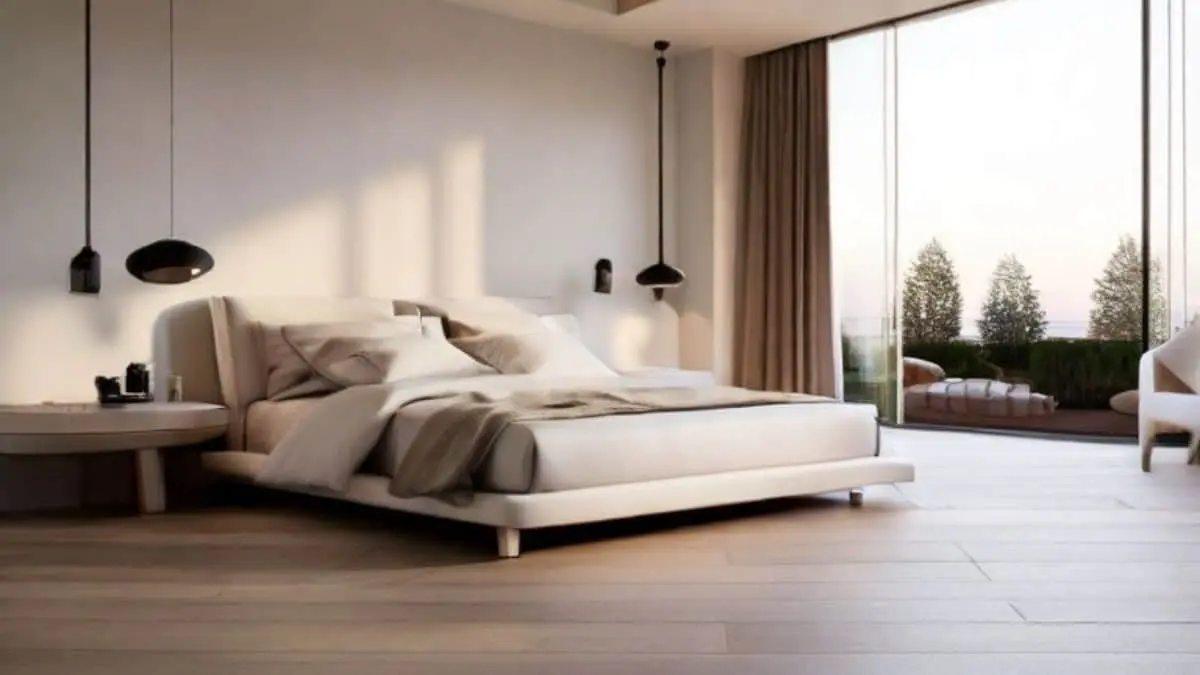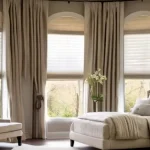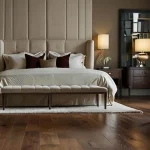Bedroom flooring shapes the comfort and style of a space. Hardwood, carpet, or tile can transform a room’s ambiance, warmth, and functionality. The right choice enhances relaxation, complements decor, and boosts home value.
For example, cozy bedroom floors like cork or carpet create a soft retreat, while durable hardwood elevates elegance. This article explores five top bedroom flooring options, detailing benefits, challenges, and best practices.
Homeowners seeking stylish, practical solutions will find clear guidance to make informed decisions for their bedroom flooring needs.
Why Bedroom Flooring Matters

Bedroom flooring defines a space’s comfort, style, and functionality. Materials like hardwood, carpet, or luxury vinyl plank shape how a room feels and performs. The right choice creates a serene retreat, enhances aesthetics, and boosts property value. Four critical factors highlight its significance.
Comfort and Warmth
Bedroom flooring directly affects physical comfort. Soft materials like carpet or cork provide warmth and cushioning, ideal for barefoot walking. Carpet, for example, offers a plush feel, easing morning routines. In contrast, hardwood or ceramic tile can feel cold, particularly in winter, often requiring area rugs for insulation.
Noise reduction is also key. Carpet absorbs sound, reducing footsteps by up to 30 decibels compared to hardwood, according to 2025 flooring studies. This makes it perfect for upstairs bedrooms or homes with children. Hardwood may need acoustic underlayment to minimize echo. Cozy bedroom floors enhance relaxation and improve sleep quality.
Style and Aesthetics
Flooring anchors a bedroom’s visual appeal. Hardwood provides timeless elegance, complementing diverse styles. Light ash suits airy Scandinavian designs, while dark mahogany fits luxurious, traditional rooms. Wood-look porcelain tiles replicate hardwood’s look at a lower cost, aligning with modern minimalist trends.
Color and texture influence ambiance. Neutral carpets create a soothing effect, while textured tiles add character. In 2025, 65% of homeowners preferred light-toned flooring for its adaptability, per design industry reports. Bedroom flooring options must harmonize with decor to craft a cohesive, inviting space.
Durability and Maintenance
Bedroom floors endure daily use, even in low-traffic areas. Hardwood and luxury vinyl plank resist wear, lasting 20-50 years with proper maintenance. Carpet, while comfortable, may show signs of wear in 5-10 years, especially in homes with pets or heavy furniture.
Maintenance needs vary. Hardwood requires refinishing every 7-10 years, while luxury vinyl plank needs only occasional mopping. Carpet demands weekly vacuuming and annual deep cleaning to prevent allergen buildup. High-pile carpets require 2-3 cleanings yearly. Durable, low-maintenance flooring ensures long-term functionality.
Home Value and Appeal
Flooring impacts a home’s resale potential. Hardwood floors increase property value, with 60% of buyers willing to pay a premium, per 2025 real estate data. Engineered hardwood offers comparable appeal at a reduced cost. Carpet, unless hypoallergenic, may deter buyers concerned about allergies.
Consistent flooring enhances marketability. Extending oak hardwood from living areas to bedrooms creates a unified look, appealing to buyers. Strategic bedroom flooring choices balance aesthetic appeal and financial return, making them a valuable investment.
Factors to Consider When Choosing Bedroom Flooring

Selecting the best flooring for bedrooms requires balancing multiple factors. Materials like hardwood, carpet, or cork each offer unique benefits and challenges. Five key considerations guide homeowners to choices that suit their needs, style, and budget.
Comfort and Warmth
Comfort is critical for bedroom flooring. Soft options like carpet or cork provide a warm, cushioned surface, ideal for barefoot walking. Carpet, for instance, feels plush and insulates against cold, enhancing morning comfort. Hardwood or tile, while durable, can feel chilly, often needing rugs for warmth.
Noise reduction also matters. Carpet absorbs sound, reducing footsteps by up to 30 decibels compared to hardwood, per 2025 flooring studies. This suits homes with children or upstairs bedrooms. Cork offers similar sound-dampening benefits. Prioritizing cozy bedroom floors ensures a relaxing, quiet space for rest.
Durability and Maintenance
Bedroom flooring must withstand daily use. Hardwood and luxury vinyl plank (LVP) resist scratches and dents, lasting 20-50 years with proper care. Carpet, while soft, may wear out in 5-10 years, especially with pets or heavy furniture, requiring replacement sooner.
Maintenance varies by material. Hardwood needs refinishing every 7-10 years, while LVP requires simple mopping. Carpet demands weekly vacuuming and 1-2 deep cleanings annually to prevent dust buildup. For example, high-pile carpets need more frequent care than low-pile options. Durable, low-maintenance flooring saves time and effort.
Style and Aesthetics
Flooring shapes a bedroom’s visual appeal. Hardwood offers timeless elegance, with light oak suiting Scandinavian designs and dark walnut fitting traditional rooms. Wood-look porcelain tiles mimic hardwood’s aesthetic at a lower cost, aligning with minimalist trends popular in 2025.
Color and texture influence ambiance. Neutral carpets create calm, while patterned tiles add character. In 2025, 65% of homeowners chose light-toned flooring for versatility, per design surveys. Bedroom flooring options should complement decor, ensuring a cohesive, stylish space that reflects personal taste.
Budget and Installation
Cost is a key factor. Hardwood ranges from $6-$12 per square foot, with installation adding $3-$5 per square foot, per 2025 market data. Carpet is more affordable at $2-$5 per square foot, while LVP costs $3-$7. Cork and tile fall between $4-$10 per square foot.
Installation complexity varies. LVP and some carpets allow DIY installation, saving up to 30% on labor costs. Hardwood and tile often require professionals, increasing expenses. Balancing upfront costs with long-term durability ensures budget-friendly bedroom flooring choices that deliver value.
Eco-Friendliness
Sustainable flooring appeals to eco-conscious homeowners. Bamboo grows rapidly, maturing in 5-7 years, compared to oak’s 20-30 years, making it a renewable choice. Cork, harvested from tree bark, is biodegradable and hypoallergenic. Reclaimed hardwood reduces deforestation while adding character.
Eco-friendly options also improve indoor air quality. Low-VOC carpets and sealants minimize harmful emissions, benefiting health. In 2025, 40% of homeowners prioritized green materials, per industry reports. Choosing sustainable bedroom flooring supports environmental goals and creates healthier living spaces.
Top 5 Bedroom Flooring Options for Comfort & Style
Bedroom flooring blends comfort, style, and practicality. Options like hardwood, carpet, and cork cater to diverse needs and aesthetics. Below are five top bedroom flooring options, each with unique strengths and considerations for creating a cozy, stylish space.
1. Hardwood Flooring

Benefits
Hardwood delivers timeless elegance. Oak, maple, or walnut suit modern, traditional, or Scandinavian designs. It boosts home value, with 60% of buyers paying a premium, per 2025 real estate data. With proper care, hardwood lasts 20-50 years, offering unmatched durability.
Its versatility enhances decor. Light tones brighten small bedrooms, while dark finishes add luxury. Hardwood resists wear from daily use, making it ideal for long-term investment.
Challenges
Hardwood costs $6-$12 per square foot, plus $3-$5 for installation, per 2025 market data. It’s prone to scratches from pets or furniture, requiring regular maintenance. Water exposure can cause warping, and hardwood feels cold without rugs, impacting comfort in winter.
Best Practices
Prefinished hardwood simplifies installation, reducing labor time by 20%. Area rugs add warmth and protect surfaces, especially in high-traffic areas. Engineered hardwood, costing $4-$8 per square foot, offers similar aesthetics with better resistance to humidity.
Expert Insight
Hardwood excels in modern or traditional bedrooms. Pair light oak with neutral walls for a cohesive look. Refinishing every 7-10 years maintains its luster, ensuring lasting appeal.
2. Carpet

Benefits
Carpet provides unmatched softness, creating cozy bedroom floors. Nylon or polyester options reduce noise by up to 30 decibels, per 2025 flooring studies, ideal for upstairs rooms. Available in colors like beige, gray, or blue, it suits any decor style.
It’s budget-friendly, costing $2-$5 per square foot. Textures like low-pile or shag enhance comfort, making carpet perfect for relaxation-focused spaces.
Challenges
Carpet traps dust and allergens, requiring frequent cleaning. Stains from spills or pets are common, especially on light colors. It wears out in 5-10 years, needing replacement sooner than hardwood or tile.
Best Practices
Low-pile carpets ease maintenance, needing vacuuming only once weekly. Stain-resistant fibers, like solution-dyed nylon, withstand spills better. A high-quality pad, costing $0.50-$1 per square foot, boosts comfort and extends carpet life.
Expert Insight
Carpet suits colder climates for insulation. It creates a plush ambiance, ideal for family bedrooms. Hypoallergenic options minimize health concerns for allergy-prone residents.
3. Luxury Vinyl Plank (LVP)

Benefits
LVP mimics hardwood’s look at $3-$7 per square foot, per 2025 data. It’s water-resistant, resisting humidity better than hardwood, and feels softer underfoot than tile. DIY-friendly click-lock systems cut installation costs by 30%.
Available in oak, hickory, or gray finishes, LVP fits minimalist or Scandinavian styles. Its durability handles daily wear, lasting 15-25 years.
Recommend Post : How to Install Vinyl Plank Flooring on Stairs
Challenges
LVP adds less resale value than hardwood, appealing to 40% fewer buyers. Prolonged sunlight can fade colors, requiring UV-protective window treatments. Synthetic materials limit eco-friendliness compared to cork or bamboo.
Best Practices
Choose LVP with a 20-mil wear layer for durability. Underlayment, costing $0.50-$1 per square foot, enhances comfort and soundproofing. Light wood tones create a modern, spacious feel in small bedrooms.
Expert Insight
LVP suits budget-conscious homeowners seeking stylish bedroom flooring ideas. It balances cost and aesthetics, making it a practical choice for modern designs.
4. Cork Flooring

Benefits
Cork is naturally soft, warm, and eco-friendly, harvested from renewable tree bark. It insulates against cold and reduces noise by 20-25 decibels, per 2025 studies, rivaling carpet. Hypoallergenic properties resist mold, benefiting allergy sufferers.
Its earthy tones suit bohemian or coastal bedrooms. Cork lasts 15-30 years with proper sealing, offering sustainable durability.
Challenges
Cork costs $4-$8 per square foot and scratches easily without sealant. Heavy furniture can cause dents, and color options are limited compared to carpet or tile. Maintenance requires resealing every 3-5 years.
Best Practices
Apply polyurethane sealant every 3-5 years to prevent scratches. Furniture pads, costing $5-$10 per set, avoid dents. Pair cork with earthy decor for a natural, organic aesthetic.
Expert Insight
Cork appeals to eco-conscious homeowners prioritizing health and comfort. Its unique texture adds warmth, enhancing bohemian or coastal bedroom vibes.
5. Ceramic or Porcelain Tile

Benefits
Ceramic and porcelain tiles resist moisture, scratches, and stains, lasting 20-50 years. Wood-look tiles mimic hardwood, while patterned designs suit modern or eclectic styles. They’re easy to clean, needing only damp mopping.
Costs range from $4-$10 per square foot, per 2025 data. Tiles offer design flexibility, fitting bold or minimalist bedrooms.
Challenges
Tiles feel cold and hard without rugs or underfloor heating, costing $5-$10 per square foot to install. Professional installation, at $3-$6 per square foot, raises expenses. Grout lines require cleaning every 6-12 months to prevent discoloration.
Best Practices
Radiant floor heating improves warmth, ideal for cold climates. Large-format tiles, 12×24 inches, minimize grout lines for a sleek look. Plush rugs add comfort and style.
Expert Insight
Tiles suit warm climates or modern designs. Wood-look porcelain offers hardwood’s aesthetic with superior durability, perfect for low-maintenance bedrooms.
How to Choose the Best Flooring for Your Bedroom

Choosing the best flooring for bedrooms requires balancing comfort, style, and practicality. Options like hardwood, carpet, or luxury vinyl plank each suit different needs. Assessing lifestyle, design goals, climate, and budget ensures a choice that enhances your space. Below is a framework to guide your decision, including a comparison table for clarity.
Lifestyle needs shape flooring choices. Families with pets or children benefit from durable, stain-resistant materials like luxury vinyl plank, which withstands scratches and spills, lasting 15-25 years. Carpet, while cozy, traps pet hair and requires 1-2 deep cleanings yearly, per 2025 flooring data.
Allergy sufferers should prioritize hypoallergenic options like cork or low-VOC hardwood, which reduce indoor pollutants by up to 50% compared to standard carpet. For high-traffic bedrooms, hardwood or porcelain tile resists wear, unlike carpet, which may show wear in 5-10 years. Evaluate daily routines to select flooring that aligns with your household’s demands.
Design goals influence aesthetic choices. Hardwood, like oak or maple, complements modern or traditional styles, with light tones suiting Scandinavian decor and dark finishes fitting luxurious rooms. In 2025, 65% of homeowners favored light-toned flooring for versatility, per design surveys.
Carpet in neutral shades like beige or gray creates a calming effect, ideal for minimalist bedrooms. Wood-look ceramic tiles offer hardwood’s elegance at $4-$10 per square foot, compared to hardwood’s $6-$12. Patterned tiles add flair for eclectic designs. Choose bedroom flooring options that match your decor vision for a cohesive look.
Climate and insulation needs affect comfort. In cold regions, carpet or cork insulates best, retaining heat and reducing noise by 20-30 decibels, per 2025 studies. Hardwood or tile feels chilly without rugs or radiant heating, which costs $5-$10 per square foot to install.
In humid climates, luxury vinyl plank or porcelain tile resists moisture, unlike hardwood, which may warp. For example, LVP handles 60% higher humidity levels than oak. Consider your region’s weather to ensure flooring maintains comfort and durability year-round.
Budget and maintenance costs guide long-term value. Hardwood, at $6-$12 per square foot, offers durability but requires refinishing every 7-10 years, costing $1-$3 per square foot. Carpet, at $2-$5 per square foot, is affordable but needs replacement in 5-10 years.
Luxury vinyl plank, at $3-$7, balances cost and longevity, needing only mopping. Cork and tile, at $4-$10, require periodic sealing or grout cleaning. DIY-friendly options like LVP save 30% on installation, unlike tile, which needs professionals. Weigh upfront and ongoing costs to find cost-effective flooring.
The table below compares the five flooring options based on key factors, helping you make an informed choice.
| Flooring Type | Cost (per sq ft) | Comfort (1-5) | Durability (Years) | Style Versatility | Maintenance Level |
| Hardwood | $6-$12 | 3 | 20-50 | High | Medium |
| Carpet | $2-$5 | 5 | 5-10 | Medium | High |
| Luxury Vinyl Plank | $3-$7 | 4 | 15-25 | High | Low |
| Cork | $4-$8 | 5 | 15-30 | Medium | Medium |
| Ceramic/Porcelain Tile | $4-$10 | 2 | 20-50 | High | Low |
This framework ensures your bedroom flooring aligns with lifestyle, aesthetics, climate, and budget, creating a comfortable, stylish space.
Maintenance Tips for Long-Lasting Bedroom Floors
Proper maintenance extends the life of bedroom flooring, ensuring durability and beauty. Hardwood, carpet, luxury vinyl plank, cork, and tile each require specific care. General and material-specific strategies keep floors in top condition, saving time and money. Below are practical tips to maintain your bedroom flooring options effectively.
General Maintenance
Regular care prevents damage across all flooring types. Dust and dirt can scratch surfaces or trap allergens, reducing floor lifespan. Simple habits maintain appearance and functionality.
- Sweep or vacuum weekly to remove dust and debris. Use a soft-bristle broom or vacuum without a beater bar to avoid scratches. This reduces surface wear by 20%, per 2025 flooring studies.
- Clean spills immediately with a damp cloth. Excess moisture can warp hardwood or stain carpet, causing damage within minutes.
- Use manufacturer-recommended cleaners. Harsh chemicals can strip finishes, affecting 30% of hardwood and tile surfaces, per industry data.
- Place doormats at bedroom entrances. Mats trap 80% of dirt from shoes, minimizing abrasion on floors like cork or LVP.
These steps apply universally, protecting cozy bedroom floors from premature wear.
Similar Post : Minimalist Bedroom Design
Material-Specific Tips
Each flooring material demands tailored care to maximize longevity. Hardwood, carpet, luxury vinyl plank, cork, and tile have unique needs based on their properties.
- Hardwood: Refinish every 7-10 years, costing $1-$3 per square foot, to restore shine and protect against scratches. Avoid water-based cleaning; use a dry or slightly damp mop to prevent warping, which affects 25% of untreated hardwood, per 2025 data. Furniture pads, costing $5-$10 per set, prevent dents.
- Carpet: Deep clean annually with a professional steam cleaner, costing $100-$200 for a standard bedroom, to remove allergens. Treat stains within 5 minutes using a carpet-safe cleaner to prevent permanent marks. Vacuum high-pile carpets twice weekly to reduce dust buildup by 50%.
- Luxury Vinyl Plank (LVP): Mop with a mild detergent and water monthly; avoid bleach, which damages 40% of LVP surfaces, per industry reports. Place felt pads under furniture to prevent scratches. Clean with a soft cloth to maintain the 20-mil wear layer’s integrity.
- Cork: Reseal with polyurethane every 3-5 years, costing $1-$2 per square foot, to protect against scratches and moisture. Avoid heavy furniture movement; use coasters to prevent dents, which occur in 15% of unsealed cork floors. Clean with a damp mop and cork-safe cleaner.
- Ceramic/Porcelain Tile: Clean grout lines every 6-12 months with a grout-specific cleaner, costing $10-$20 per bottle, to prevent discoloration. Reseal grout annually to block moisture, reducing mold risk by 70%, per 2025 studies. Mop tiles weekly with a neutral cleaner to maintain shine.
Tailored maintenance ensures each flooring type performs well, keeping bedroom floors durable and attractive for years.
FAQ
What is the best flooring for a cozy bedroom?
Carpet and cork are top choices for cozy bedroom floors. Carpet offers plush softness and reduces noise by 30 decibels, per 2025 studies, ideal for relaxation. Cork provides warmth, insulation, and hypoallergenic properties, enhancing comfort.
Is hardwood flooring good for bedrooms?
Hardwood flooring is excellent for bedrooms. It offers durability, lasting 20-50 years, and boosts home value, with 60% of buyers paying more, per 2025 data. Pair with rugs for warmth to offset its cooler feel.
What is the most budget-friendly bedroom flooring option?
Luxury vinyl plank (LVP) is the most budget-friendly. Costing $3-$7 per square foot, LVP mimics hardwood, is easy to install, and requires minimal maintenance, saving 30% on labor costs, per 2025 market data.
How do I maintain bedroom flooring?
Regular sweeping, material-specific cleaners, and immediate spill cleanup maintain bedroom floors. Hardwood needs refinishing every 7-10 years, carpet requires annual deep cleaning, and tile grout needs sealing yearly, per 2025 flooring studies.
Can I install bedroom flooring myself?
Luxury vinyl plank and some carpets are DIY-friendly. LVP’s click-lock system saves 30% on installation costs. Hardwood and tile typically require professional installation, costing $3-$6 per square foot, for best results.



